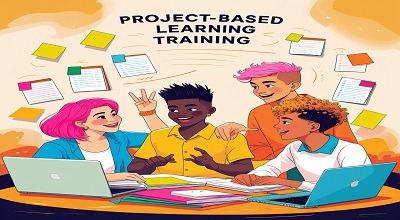Project-Based Learning Training
Project-Based Learning Training: Project-Based Learning (PBL) is an innovative teaching method where students gain knowledge and skills by working on real-world projects over an extended period. Unlike traditional lecture-based learning, PBL emphasizes hands-on experiences, collaboration, and critical thinking.
PBL is student-centered, allowing learners to explore complex questions, solve problems, and create tangible outcomes. It aligns with modern educational goals, fostering creativity, teamwork, and lifelong learning skills.
Benefits of Project-Based Learning
Enhances Critical Thinking & Problem-Solving
PBL challenges students to analyze, evaluate, and synthesize information, improving their cognitive abilities.
Promotes Collaboration & Communication
Students work in teams, enhancing interpersonal skills and preparing them for real-world work environments.
Increases Engagement & Motivation
Real-world relevance makes learning more exciting and meaningful for students.
Develops Research & Self-Learning Skills
Learners take ownership of their education by conducting research and applying knowledge practically.
Prepares Students for Future Careers
PBL mimics workplace projects, helping students develop job-ready skills.
Key Components of Effective PBL
For PBL to be successful, it should include:
- Driving Question: A challenging problem or question that guides the project.
- Student Voice & Choice: Learners have autonomy in decision-making.
- Authenticity: Projects should relate to real-world issues.
- Reflection: Students analyze their learning process.
- Public Product: A final presentation or tangible outcome shared with an audience.
Steps to Implement Project-Based Learning
Define the Project Goal
Identify the learning objectives and desired outcomes.
Choose a Relevant Topic
Select a real-world problem that interests students.
Plan the Project Timeline
Break the project into phases with deadlines.
Facilitate Research & Exploration
Provide resources and guidance as students investigate.
Encourage Collaboration
Group work enhances peer learning.
Assess & Reflect
Evaluate both the process and final product.
Latest Trends in Project-Based Learning
- AI & PBL Integration: Using AI tools for research and project development.
- Global Collaboration Projects: Students working with peers worldwide.
- Sustainability-Focused PBL: Projects addressing climate change and eco-friendly solutions.
- Gamification in PBL: Adding game elements to enhance engagement.
Real-World Examples of PBL in Education
Building a Sustainable City (Science & Engineering)
Students design eco-friendly urban models.
Creating a Business Plan (Economics)
Learners develop and pitch startup ideas.
Documentary on Social Issues (History & Media Studies)
Students research and produce films on societal challenges.
Coding & App Development (Computer Science)
Designing functional apps to solve community problems.
Challenges and Solutions in PBL
| Challenge | Solution |
|---|---|
| Time Constraints | Use structured timelines & milestones |
| Student Resistance | Provide engaging, relevant topics |
| Assessment Difficulties | Use rubrics & peer evaluations |
| Resource Limitations | Leverage free online tools & community partnerships |
How Teachers Can Get Trained in PBL?
Teachers can enhance their PBL skills through:
- Online Courses (Coursera, edX)
- Workshops & Webinars (Buck Institute for Education)
- Peer Collaboration (Professional Learning Communities)
- Certification Programs (PBLWorks)
For more teacher training resources, visit TeacherEducator.com.
Frequently Asked Questions (FAQs)
Q1: How is PBL different from traditional learning?
A: PBL focuses on active, student-driven projects rather than passive lectures.
Q2: Can PBL work for all subjects?
A: Yes, PBL can be adapted for STEM, humanities, and arts.
Q3: How do you assess PBL?
A: Through rubrics, presentations, and self/peer assessments.
Conclusion
Project-Based Learning transforms education by making it interactive, relevant, and skill-focused. By integrating PBL strategies, teachers can prepare students for future challenges. For more insights on teacher training, explore TeacherEducator.com.
